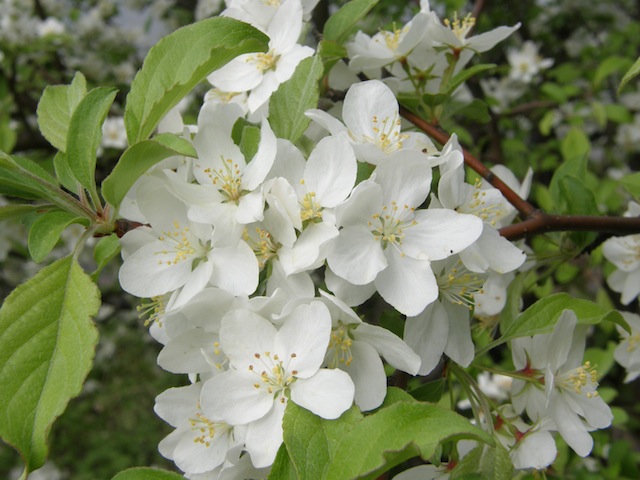Rosaceae, the rose family.
Description:
Plant:
Group of
Small to medium-sized trees with broken, irregular or warty gray bark, growing to 20 feet,
occasionally larger.
White to pink or even red flowers appear in spring. Widely planted as an ornamental.
Small, 1/4" - 1", sour, apple-like fruit usually red or pink, but sometimes yellow ripens in the fall.
Flowers:
White to pink, with five petals in the wild versions, five sepals,
and many stamens, 3/4"-1".
Appearing in spring and opening just after the first leaves emerge.
The flowers occur in small clusters, (corymbs) usually 5-9, but sometimes in
cluster of 20 or more, on fruiting spikes
formed the previous year.
There are a large number of ornamental cultivars, some with doubled petals.
Leaves:
Alternate, ovate, with toothed margins and short petiols.
Fruit:
Red, pink or sometimes yellow, appearing as small apples, 1/4"-1", occasionally larger.
Usually very sour, often astringent; varying greatly between varieties, some tart and
slightly sweet, others woody, bitter, and nearly inedible.
Blooming:
April-May
Habitat:
Old yards, parks, and farms, thickets and undergrowth. Spreads widely by seed distributed by birds.
Comments:
Spring blooming tree, widely planted as an ornamental, crab apples are derived from
various wild apples. One of the wild apples, M. sieversii is the ancestor of the
cultivated apple. Several species (30-50) are recognized by botanists, but the group
has been so scrambled by hybridization and cultivation, that the specific names are largely
meaningful only in their original range. There are some species native to North America, but
most of the crabs found growing "wild" are naturalized from ornamental stock derived from
Eurasian anscesters. These have generally been so mixed by human and natural hybridization
that it is not possible to assign a particular species. Domestic apples M. domestica
often get into the mix as well.
Larger, sweeter wild-growing apples are generally within a couple of generations of
somebody's fruit orchard.
Though sour, many of the crab apples make excellent, well-colored and flavored Jelly,
and find use in other tart condiments.
Where to find it:
Widespread in brushy and forest boundary areas of the park.
Some of the trees seem to be original plantings; others are obviously naturalized.
